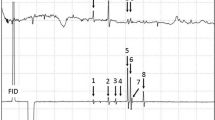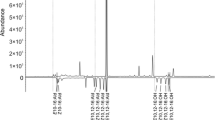Abstract
Swede midge, Contarinia nasturtii Kieffer, is an invasive cecidomyiid pest that causes serious losses of Brassica oilseed and vegetable crops in the Northeastern U.S. and Canada. Currently, few alternatives to systemic insecticides exist for its management. Because a single feeding larva can render heading Brassica crops unmarketable, management strategies that prevent oviposition are needed urgently. Pheromone-mediated mating disruption is a promising management approach for swede midge because it prevents mating and subsequent crop damage. While the swede midge pheromone has been identified, one of the major barriers to using it in mating disruption is the high cost of synthesis. Racemic blends, consisting of natural and non-natural stereoisomers, could be useful for mating disruption because they are cheaper to produce. However, it is not clear whether racemic pheromone blends attract males and/or prevent them from locating and mating with females. Here, we studied the behavior of male swede midge in Y-tube and wind tunnel bioassays to pheromone blends. Specifically, we tested whether males: (1) are attracted to different doses of pheromone, (2) discriminate between blends comprising natural stereospecific or racemic components, or a combination thereof, and (3) are able to locate and copulate with females in pheromone-permeated olfactometers. We found that picogram amounts of pheromone attracted males and prevented them from locating females in y-tube olfactometers. While males were more attracted to stereospecific blends, compared to racemic blends, all blends tested prevented nearly all males mating with females. Therefore, low dose racemic blends may be promising for pheromone-mediated mating disruption.






Similar content being viewed by others
References
Andaloro JT, Hoy CW, Rose KB, Shelton AM (1983) Evaluation of insecticide usage in the New York processing-cabbage pest management program. J Econ Entomol 76:1121–1124
Andersson MN, Haftmann J, Stuart JJ, Cambron SE, Harris MO, Foster SP, Franke S, Francke W, Hillbur Y (2009) Identification of sex pheromone components of the hessian fly, Mayetiola destructor. J Chem Ecol 35:81–95. https://doi.org/10.1007/s10886-008-9569-1
Arakaki N, Hokama Y, Nagayama A, Yasui H, Fujiwara-Tsujii N, Tanaka S, Mochizuki F, Naito T, Hongo T, Wakamura S (2013) Mating disruption for control of the white grub beetle Dasylepida ishigakiensis (Coleoptera: Scarabaeidae) with synthetic sex pheromone in sugarcane fields. Appl Entomol Zool 48:441–446. https://doi.org/10.1007/s13355-013-0202-6
Benatti TR, Valicente FH, Aggarwal R, Zhao C, Walling JG, Chen MS, Cambron SE, Schemerhorn BJ, Stuart JJ (2010) A neo-sex chromosome that drives postzygotic sex determination in the hessian fly (Mayetiola destructor). Genetics 184:769–777. https://doi.org/10.1534/genetics.109.108589
Bergh JC, Harris MO, Rose S (1990) Temporal patterns of emergence and reproductive behavior of the hessian fly (Diptera: Cecidomyiidae). Ann Entomol Soc Am 83:998–1004
Boddum T, Skals N, Wirén M, Baur R, Rauscher S, Hillbur Y (2009) Optimisation of the pheromone blend of the swede midge, Contarinia nasturtii, for monitoring. Pest Manag Sci 65:851–856. https://doi.org/10.1002/ps.1762
Boddum T, Skals N, Hill SR, Hansson BS, Hillbur Y (2010) Gall midge olfaction: pheromone sensitive olfactory neurons in Contarinia nasturtii and Mayetiola destructor. J Insect Physiol 56:1306–1314. https://doi.org/10.1016/j.jinsphys.2010.04.007
Cardé RT, Minks AK (1995) Control of moth pests by mating disruption: successes and constraints. Annu Rev Entomol 40:559–585. https://doi.org/10.1146/annurev.ento.40.1.559
Chen M, Shelton AM, Hallett RH, Hoepting CA, Kikkert JR, Wang P (2011) Swede midge (Diptera: Cecidomyiidae): ten years of invasion of crucifer crops in North America. J Econ Entomol 104:709–716. https://doi.org/10.1603/EC10397
Daly KC, Figueredo AJ (2000) Habituation of sexual response in male Heliothis moths. Physiol Entomol 25:180–190. https://doi.org/10.1046/j.1365-3032.2000.00184.x
Evans BG, Hallett RH (2016) Efficacy of biopesticides for management of the swede midge (Diptera: Cecidomyiidae). J Econ Entomol 109:2159–2167. https://doi.org/10.1093/jee/tow192
Evenden ML, Judd GJR, Borden JH (1999) Pheromone-mediated mating disruption of Choristoneura rosaceana: is the most attractive blend really the most effective? Entomol Exp Appl 90:37–47. https://doi.org/10.1023/A:1003598114512
Farkas SR, Shorey HH, Gaston LK (1974) Sex pheromones of Lepidoptera: influence of pheromone-concentration and visual cues on aerial odor-trail following by males of Pectinophora gossypiella. Ann Entomol Soc Am 67:633–638
Gagne RJ (1989) The plant-feeding gall midges of North America. Cornell University Press, Ithaca
Hall DR, Amarawardana L, Cross JV, Francke W, Boddum T, Hillbur Y (2012) The chemical ecology of cecidomyiid midges (Diptera: Cecidomyiidae). J Chem Ecol 38:2–22. https://doi.org/10.1007/s10886-011-0053-y
Hallett RH (2007) Host plant susceptibility to the swede midge (Diptera: Cecidomyiidae). J Econ Entomol 100:1335–1343. https://doi.org/10.1603/0022-0493(2007)100[1335:HPSTTS]2.0.CO;2
Hallett RH, Heal JD (2001) First Nearctic record of the swede midge (Diptera: Cecidomyiidae). Can Entomol 133:713–715
Hallett RH, Sears MK (2013) Pheromone-based action thresholds for control of the swede midge, Contarinia nasturtii (Diptera: Cecidomyiidae), and residual insecticide efficacy in cole crops. J Econ Entomol 106:267–276. https://doi.org/10.1603/ec12243
Hallett RH, Goodfellow SA, Heal JD (2007) Monitoring and detection of the swede midge (Diptera: Cecidomyiidae). Can Entomol 139:700–712. https://doi.org/10.4039/n05-071
Hallett RH, Goodfellow SA, Weiss RM, Olfert O (2009) MidgEmerge, a new predictive tool, indicates the presence of multiple emergence phenotypes of the overwintered generation of swede midge. Entomol Exp Appl 130:81–97. https://doi.org/10.1111/j.1570-7458.2008.00793.x
Harris MO, Galanihe LD, Sandanayake M (1999) Adult emergence and reproductive behavior of the leafcurling midge Dasineura mali (Diptera: Cecidomyiidae). Ann Entomol Soc Am 92:748–757
Hillbur Y, Celander M, Baur R, Rauscher S, Haftmann J, Franke S, Francke W (2005) Identification of the sex pheromone of the swede midge, Contarinia nasturtii. J Chem Ecol 31:1807–1828. https://doi.org/10.1007/s10886-005-5928-3
Hodgdon EA, Hallett RH, Stratton CA, Chen YH (2018) Diel patterns of emergence and reproductive behaviour in the invasive swede midge (Diptera: Cecidomyiidae). In press
Judd GJR, Gardiner MGT, DeLury NC, Karg G (2005) Reduced antennal sensitivity, behavioural response, and attraction of male codling moths, Cydia pomonella, to their pheromone (E,E)-8,10-dodecadien-1-ol following various pre-exposure regimes. Entomol Exp Appl 114:65–78. https://doi.org/10.1111/j.0013-8703.2005.00231.x
Miller JR, Gut LJ (2015) Mating disruption for the 21st century: matching technology with mechanism. Environ Entomol 44:1–27. https://doi.org/10.1093/ee/nvv052
Onufrieva KS, Thorpe KW, Hickman AD et al (2008) Gypsy moth mating disruption in open landscapes. Agric For Entomol 10:175–179. https://doi.org/10.1111/j.1461-9563.2008.00375.x
Readshaw JL (1961) The biology and ecology of the swede midge, Contarinia nasturtii (Kieffer), (Diptera; Cecidomyiidae). Dissertation, University of Durham
Samietz J, Baur R, Hillbur Y (2012) Potential of synthetic sex pheromone blend for mating disruption of the swede midge, Contarinia nasturtii. J Chem Ecol 38:1171–1177. https://doi.org/10.1007/s10886-012-0180-0
Seaman A, Lange H, Shelton AM (2014) Swede midge control with insecticides allowed for organic production, 2013. Arthropod Manage Tests 39:E64–E64. https://doi.org/10.4182/amt.2014.E64
Shorey HH (1973) Behavioral responses to insect pheromones. Annu Rev Entomol 18:349–380. https://doi.org/10.1146/annurev.en.18.010173.002025
Stelinski LL, Miller JR, Rogers ME (2008) Mating disruption of citrus leafminer mediated by a noncompetitive mechanism at a remarkably low pheromone release rate. J Chem Ecol 34:1107–1113. https://doi.org/10.1007/s10886-008-9501-8
Stratton CA, Hodgdon EA, Zuckerman SG, Shelton AM, Chen YH (2018) A single swede midge (Diptera: Cecidomyiidae) larva can render cauliflower unmarketable. J Insect Sci 18:1–6. https://doi.org/10.1093/jisesa/iey062
Stuart JJ, Hatchett JH (1991) Genetics of sex determination in the hessian fly, Mayetiola destructor. J Hered 82:43–52
Symonds MRE, Elgar MA (2008) The evolution of pheromone diversity. Trends Ecol Evol 23:220–228. https://doi.org/10.1016/j.tree.2007.11.009
Tabadkani SM, Khansefid M, Ashouri A (2011) Monogeny, a neglected mechanism of inbreeding avoidance in small populations of gall midges. Entomol Exp Appl 140:77–84. https://doi.org/10.1111/j.1570-7458.2011.01130.x
Thorpe KW, Mastro VC, Leonard DS, Leonhardt BA, McLane W, Reardon RC, Talley SE (1999) Comparative efficacy of two controlled-release gypsy moth mating disruption formulations. Entomol Exp Appl 90:267–277. https://doi.org/10.1046/j.1570-7458.1999.00447.x
Wu Q-J, Zhao J-Z, Taylor AG, Shelton AM (2006) Evaluation of insecticides and application methods against Contarinia nasturtii (Diptera: Cecidomyiidae), a new invasive insect pest in the United States. J Econ Entomol 99:117–122. https://doi.org/10.1603/0022-0493(2006)099[0117:EOIAAM]2.0.CO;2
Acknowledgments
We thank Ylva Hillbur from the Swedish University of Agricultural Sciences for providing advice regarding pheromone doses and wind tunnel designs, Guiseppe Petrucci from the University of Vermont (UVM) Department of Chemistry for assisting with pheromone solution preparation, Alan Howard from the UVM Statistical Software Support and Consulting Services for advice on statistical analysis, the UVM campus greenhouse staff for cauliflower production, and William Louisos from the UVM College of Engineering and Mathematical Sciences for measuring the wind speed in our wind tunnel. We also thank Oliver Bevan, Paolo Filho, Christian DeRoy, Kathryn Jacobs, Brennan Kensey, Laurel Martinez, Ross Pillischer, Julia Ramseyer, Leila Rezvani, Rebecca Roman, Dylan Samson-McKenna, Justine Samuel, and Samuel Zuckerman for assistance with swede midge rearing. A USDA NIFA Crop Protection and Pest Management grant (2014-70006-22525) provided funding for these projects.
Author information
Authors and Affiliations
Corresponding author
Rights and permissions
About this article
Cite this article
Hodgdon, E.A., Hallett, R.H., Wallin, K.F. et al. Racemic Pheromone Blends Disrupt Mate Location in the Invasive Swede Midge, Contarinia nasturtii. J Chem Ecol 45, 549–558 (2019). https://doi.org/10.1007/s10886-019-01078-0
Received:
Revised:
Accepted:
Published:
Issue Date:
DOI: https://doi.org/10.1007/s10886-019-01078-0




